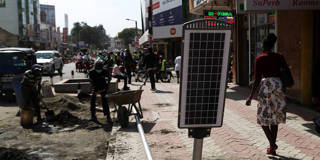The world needs new strategies to close the divide between development aspirations and realities. In the absence of programs to help struggling countries get in financial shape for the challenges that lie ahead, the goal of mobilizing trillions of dollars for climate-friendly development will remain a pipe dream.
CAMBRIDGE – Low-income countries are in the throes of a liquidity crunch that is not only undermining their economic development but also deepening the global climate crisis. In 2020 and 2021, net financial transfers to Africa were close to zero – their lowest level in a decade – despite record transfers from multilateral development banks (MDBs). That drop-off was due to a reduction in loans from the private sector and China, and now the situation has deteriorated further, with all low- and lower-middle-income countries (LMICs) having lost access to the bond market. Meanwhile, higher food and fuel bills, and falling export receipts, have made matters even worse.
To be sure, only a handful of LMICs have defaulted on their external debts, and many others still hope to weather the storm and re-enter the market when it reopens. But with their debt-service obligations having grown vastly larger than the official support they can secure, their fiscal space is being squeezed, leading to a silent development crisis.
At the same time, global development and climate financing needs are estimated to have risen to $1 trillion per year. The gap between the international community’s aspirations for poorer economies and the sad reality of their finances has never been so large, nor so corrosive to the legitimacy of the global financial system.

CAMBRIDGE – Low-income countries are in the throes of a liquidity crunch that is not only undermining their economic development but also deepening the global climate crisis. In 2020 and 2021, net financial transfers to Africa were close to zero – their lowest level in a decade – despite record transfers from multilateral development banks (MDBs). That drop-off was due to a reduction in loans from the private sector and China, and now the situation has deteriorated further, with all low- and lower-middle-income countries (LMICs) having lost access to the bond market. Meanwhile, higher food and fuel bills, and falling export receipts, have made matters even worse.
To be sure, only a handful of LMICs have defaulted on their external debts, and many others still hope to weather the storm and re-enter the market when it reopens. But with their debt-service obligations having grown vastly larger than the official support they can secure, their fiscal space is being squeezed, leading to a silent development crisis.
At the same time, global development and climate financing needs are estimated to have risen to $1 trillion per year. The gap between the international community’s aspirations for poorer economies and the sad reality of their finances has never been so large, nor so corrosive to the legitimacy of the global financial system.